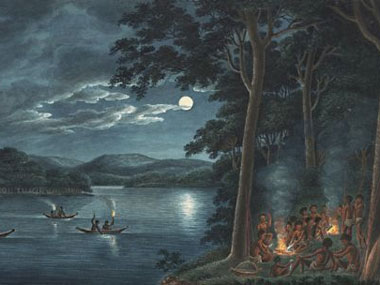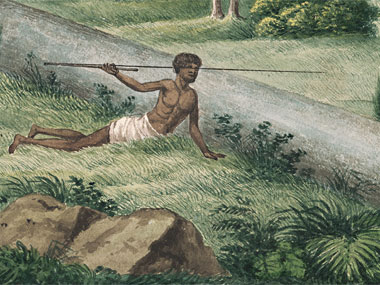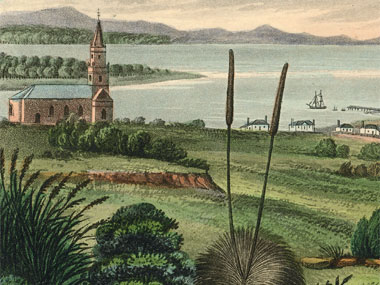A Lycett for Christmas

Joseph Lycett's 'Fishing by Torchlight', watercolour 17.7 x 27.9 cms
Jeremy Eccles | 18.12.14
Author: Jeremy Eccles
News source: Review
A delightful project has emerged from the National Library in Canberra and the University of Newcastle's Wollotuka Institute of Aboriginal Studies. “True Light and Shade” takes the early 19th Century artworks of that infamous forger Joseph Lycett and sets them into the Aboriginal context of that time – where they may have been painted, what the Indigenous subjects of the paintings may have been doing and what mythology may have been in the wind in a time “before the cultural destruction (of colonialism) impacted”.
And presumably, with only 250 convicts in the high-security Coal River settlement (as Newcastle was initially called), there was a much slower decimation of the native population through imported disease than had been the case in Sydney.
Lycett was transported for 14 years for forgery in 1811 – a lucky man as two thirds of guilty forgers were hanged. It was such a common crime, it needed exemplary punishment. He was even luckier in that he received an almost immediate ticket of leave to work with the printer Absolem West – but blew his luck by turning to forgery once again in 1815. That gave him 3 years hard labour in Coal River; but after just one year, a new superintendent decided that he wanted this “scenic wonderland” captured, and Lycett was ordered to set to to immortalise the Nature, the locals and any grand new buildings as they arose. Indeed one of them, Christ Church, seems to have been designed as well by the artist, and formally opened by Governor Macquarie, who must have thought he'd found himself another Greenaway. (NB – a new biography of Greenaway has also just been published).
By 1822, back in Sydney, Lycett had somehow come up with enough money to buy his way back to Britain – though the source of those funds is unknown. Did sell art, indulge in more forgery, or, the most likely, obtain the money from his new best friend James Squire, pioneering brewer and the man who still gives his name to excellent beer.
Sadly, it was downhill all the way from there for Lycett – the high life in Chelsea briefly as he published his book, 'Views of Australia' in 1824, then to Birmingham as the book sold less well than hoped, then yet more forgery, arrest and a dramatic suicide by cutting his own throat rather than be recommitted to Australia!
Worimi academic John Maynard's new book isn't based on that English publication but on 'The Lycett Album' of twenty original watercolour and gouache works once owned by Governor La Trobe in the 1850s and smartly bought by the National Library in 1972.
It reveals that Lycett was never going to be a portrait painter, but he could manage a very realistic body and closely observed the details of Aboriginal life (with a special affection for camp dogs), as well as revealing a perhaps-unconscious noting of significant Aboriginal landforms. Examples cited include the flattened top of Mt Yengo which is still central to the Awabakal people's respect for the great god Baime (who rose to Heaven from that flat top), and Nobby's Island (Whibay-gamba), home to the Giant Kangaroo, which finally got fed-up with white insensitivity in 1989 and threw a great earthquake at Newcastle, a city that shivered mightily on its alluvial deposits.
Maynard has gone back to contemporary literary sources as well as visual ones – with the Rev Lancelot Threlkeld having an interest comparable to Lycett's in Indigenous matters and myths – such as the delightful story which may place the painting, 'Corroboree (or should that be Caranberie?) around a Camp Fire' at Belmont Lagoon. By showing us both the original over 2 pages and then homing in on sections for special mention, Maynard links the full moon and its reflection in the waters of a billabong with the legend of Pontoe-Boong, the Man in the Moon, who gets so jealous of the sun goddess's freedom to fly in daylight and to show her full face all of the time that his tears fell for so many nights that they formed the Belmont Lagoon. When the full moon was at its brightest (maybe after an eclipse?), the Awabakal held a corroboree there, just as Lycett pictured.
But were they always so decently clad for such events? Lycett seems to have had an early fit of the Victorian vapours in adding loin-cloths to his subjects! And could we really call the nascent Newcastle an “industrial centre” as Maynard does because of its reputation for canoe-making and stone-axe manufacture? Surely that's entirely a matter of access to source material in such a society. Most intriguing is his use of the tribal name Awabakal, which Maynard admits was almost certainly invented by Threlkeld's re-publisher, John Fraser, in 1892 for the people living around Awaba – Lake Macquarie. Despite which, Maynard persists in the usage because his southern neighbours choose to identified with that name today.
'True Light and Shade' is a book to delight the eye and intrigue the mind – and it's published by NLA Publishing at $50.
URL: Purchase book from National Library of Australia Publishing
Share this:
»  del.icio.us
»
del.icio.us
»  Digg it
»
Digg it
»  reddit
»
reddit
»  Google
»
Google
»  StumbleUpon
»
StumbleUpon
»  Technorati
»
Technorati
»  Facebook
Facebook
Contact Details

'Aborigines Hunting Kangaroos' detail of the painting by Joseph Lycett. Watercolour 17.7 x 27.7cms

The church that Lycett designed - Christ Church in 'Newcastle, NSW', hand-coloured aquatint, 23.5 x 33cms
Further Research
News Tags: Aboriginal corroborees | artist/forger | Coal River | Jeremy Eccles | John Maynard | Joseph Lycett | National Library | Newcastle
News Archive
- 11.10.17 | RETURN OF MUNGO MAN
- 10.10.17 | TARNANTHI 2017
- 11.08.17 | Natsiaas 2017
- 08.08.17 | ABORIGINAL ART ECONOMICS
- 02.08.17 | SCHOLL'S NEXT MOVE
- 20.07.17 | APY ART DOMINATES THE WYNNE
- 17.07.17 | Anangu Artist Wins $100,000 Prize
- 14.07.17 | The End of AAMU
- 13.07.17 | YOU ARE HERE
- 11.07.17 | ART ACROSS THE COUNTRY
- 11.07.17 | TARNANTHI IN OCTOBER
- 05.07.17 | TJUNGUṈUTJA - from having come together
- 02.07.17 | BENNELONG
- 27.06.17 | JIMMY CHI
- 23.06.17 | Blak Markets at Barangaroo
Advertising

